Photos of portions of John Vincent's 1828 Family Bible are found on every major family research website. The nearly 200 year old bible has been of great worth to those who decended from one of John and Nicey Vincent's 16 children for generations. However, few know of the bible's provenance or where it is currently located.
The Bible is now in the Special Collections Department of the Samford University Library in Birmingham, Alabama. It is part of the Bledsoe-Kelly Collection contributed to the college by Maud Kelly before she died. The school was most pleased to receive her collection since Maud was the first woman to practice law in the State of Alabama.
My name is Ron Vincent (ronv.net) and I'd like to share more of the story of the old bible. A short / printable version of this story, including provenance, can be found in a PDF file if you CLICK HERE.
Most of John and Nicey Vincent's 16 children scattered throughout the deep south (U.S.A.). The story I learned was that Euzeba, with whom John Vincent lived for a time after his wife died, ended up with her father's bible. Some time prior to about 1905, my grandfather's sister, Ida Vincent, inherited it. Ida was Euzeba's niece, John & Nicey's granddaughter.
Before she died, my grandfather Oakley Vincent got the Bible from Ida. My Aunt Evelyn Vincent Farris got it from him when he died and I got it from her in the mid-1970s. In 1990 I gave the bible to Samford University as mentioned above.
In 2009, I visited the university library and took several photos of the old bible to document the contents, publication date, and condition of the bible. Only a few of those photos have ever been shared publicly. Here are most of the rest of them.
NOTE: CLICK EACH PHOTO BELOW TO VIEW A LARGER EXAMPLE.
If you have slow internet, the larger example may take a few seconds to download.
My aplogies for some of these photos being slightly out of focus.
photo-1
When you first make your request of the Samford University Library - Special Collections Dept. to see the old Vincent Family Bible, you must first tell them it is part of the Bledsoe-Kelly Collection and it is located in Box SC 4320. This filing system may have changed but that's where it was when I last saw it in 2009.

photo-2
When I took the bible out of the box it was tied with a string to keep the covers on. Good idea!
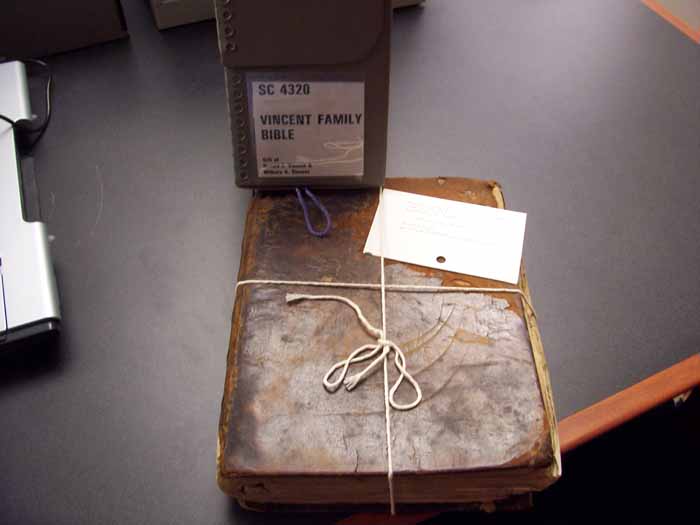
photo-3
Here's what it looks like without the string.

photo-4
This is the spine of the bible.
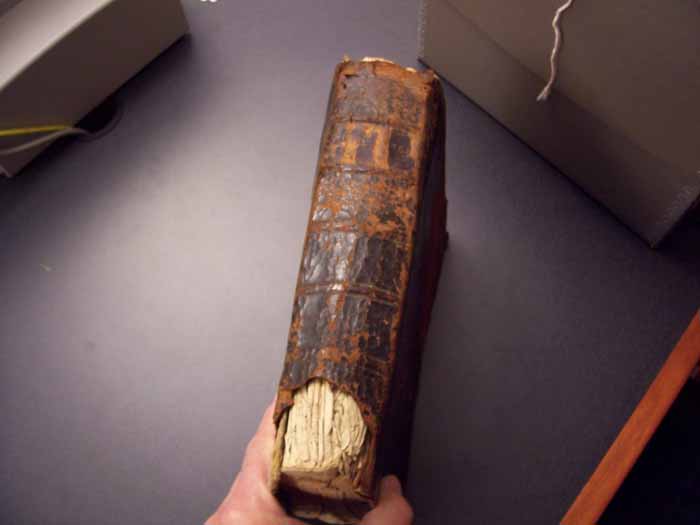
photo-5
Inside the front cover the university attached a plate saying the bible was a gift from me and my father to the university.
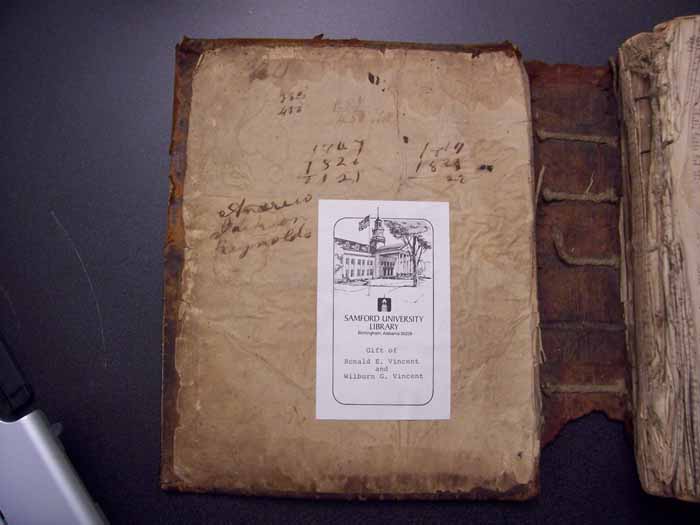
photo-6
With the bible opened, the necessity of the string that held the cover own became obvious.
As you can see, several pages are missing from the front of the book.

photo-7
Several pages were missing from the front but, fortunately, the 1828 publication date was also printed at the bottom of the cover page for the New Testament. For bibles, journals, and such, a publication date lets us know how old the book is. It also tells the researcher that no dates written in this book were recorded BEFORE that date.
10 of John & Nicey's 16 children were born before this bible was published. Therefore, their date of births were recorded in this bible AFTER they were born. This means the bible is NOT a primary source for their date of birth. However, John Vincent's date of death WAS after 1828 which makes the bible a likely PRIMARY source for his death date.
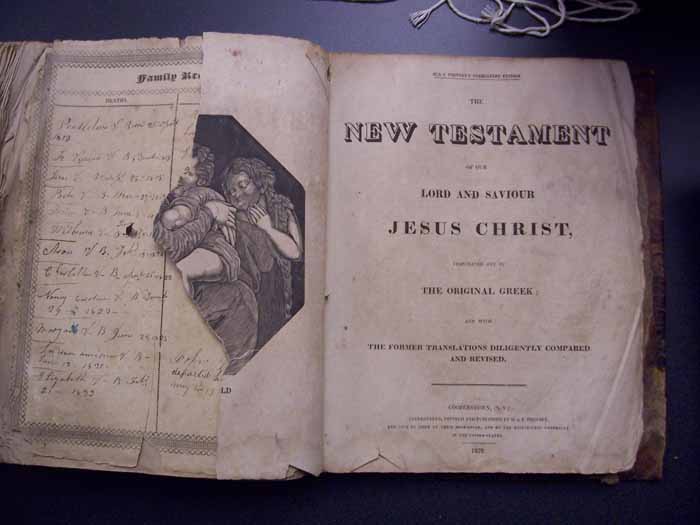
photo-8
When I turned the page to view the last of 2 pages of the "Famly Record", I could see the different hand writing of several entries. This indicates that those entries were recorded at different times.
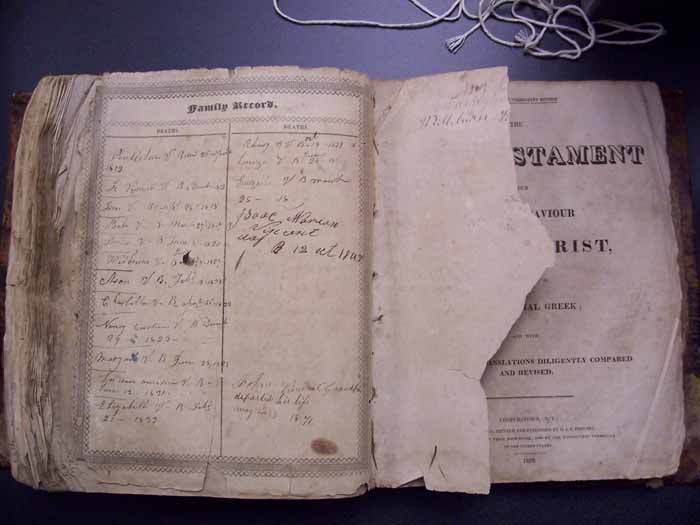
photo-9
Turning the page BACK on leaf revealed the first of 2 pages of the "Famly Record."
What you see below was taken with overhead lighting. I do not know what type lights were used.
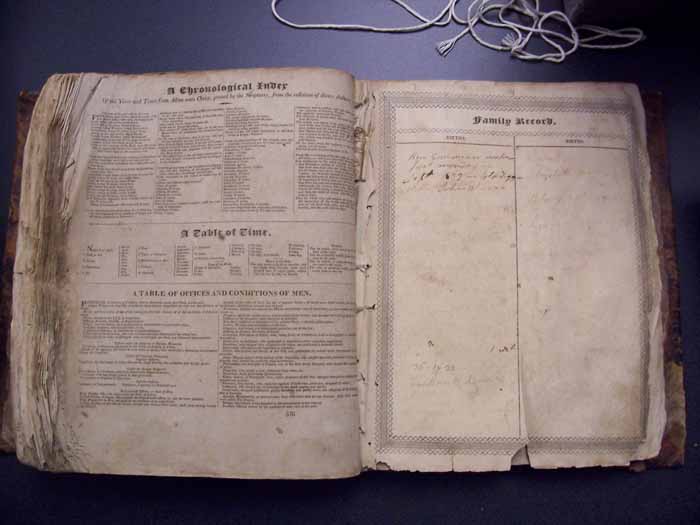
photo-10
I brought a handheld flourescent lamp with me to see if the faded ink on the page 1 was more obvious.
This light did not seem to help much at first.
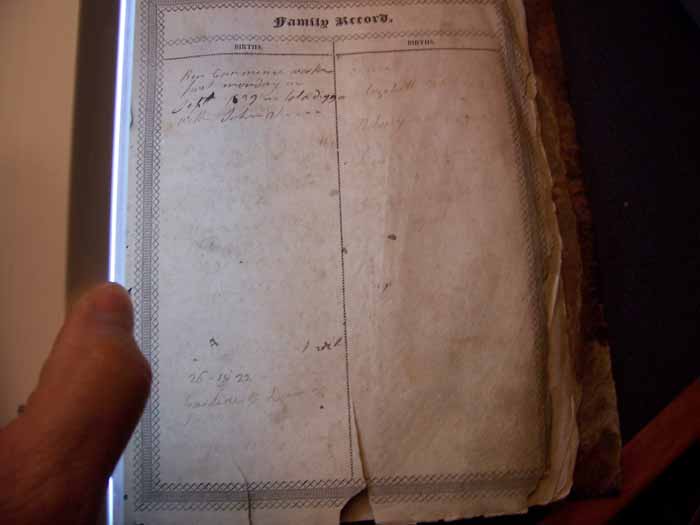
photo-11
I switched out the bulb and replaced it with an ultra-violet lamp. The faded writing here seems even harder to read, however, some of the first few letters of the oldest boys names can be made out: Pendleton or Pennington (I think his name may have changed later in life), John, and Isaac. I'm unsure who Pennington was named after but John was named after his father and Isaac was named after Nicey's father.

photo-12
I discovered when I switched back to my handheld flourescent bulb and tilted it at an angle to also allow room light from overhead, the combination of room light and my handheld flourescent seemed to make the faded writing slightly more readable.
Notice that someone had begun writing with ink that did not fade. It's a shame the same ink could have been used throughout. This says "Ben Commence[d] work first monday in Sept 1839 in Taladigga with John V _ _ _ _" None of the family members I spoke with knew what this meant.
We know that paper was a scarce commodity in new territories. We know tha that John & Nicey Vincent moved from Lincoln County, GA to Alabama sometimes between 1835 and 1840 according to Ida Vincent. We know his family ended up in Talladega County, AL. It is likely that John Vincent or Nicey wrote this work record in the only place available to them at the time. It would be nice to know who "Ben" was.
This is the top-left of the faded page 1 of the Family Record.
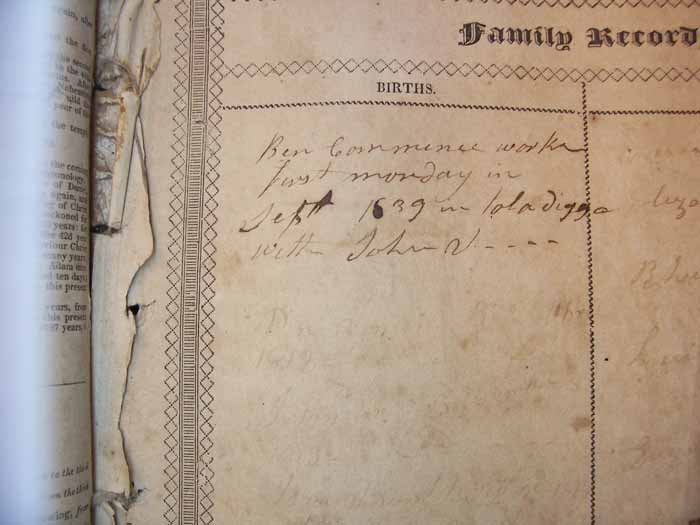
photo-13
Here's a closeup of the top-right of the faded page 1. Some of the names of John & Nicey's 16 children are readable including Louisiana, Elizabeth, Rhuey, and Louisa. Note that Louisa Catherine Vincent was born on the 24th of June, 1837. It is entirely possible that this was a record of her birth when she was born.
If you click to view the enlargement of this page, you can make out her first name which is spelled "Louiza" here, the capital letter "B" for "born", and most of the date "June 24, 18..." the rest is unreadable because of fading.
Below there, you can almost make out the first few letters of Euzeba's name but nothing else.
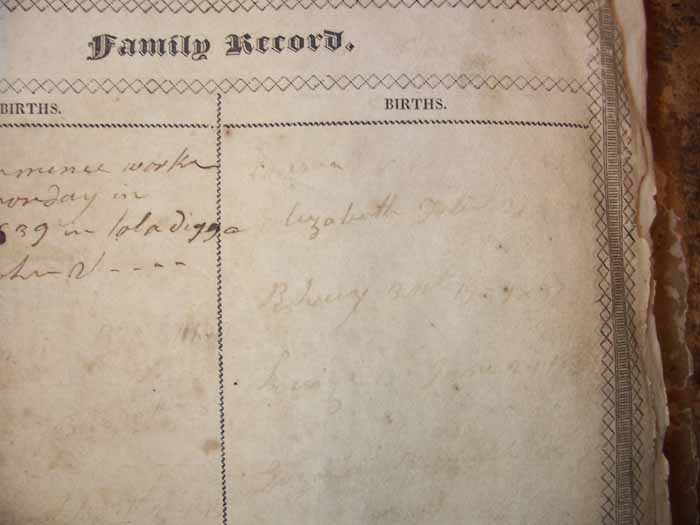
photo-14
Here's a closeup of the bottom-right of the faded page 1. There doesn't appear to be any writing in this quadrant.
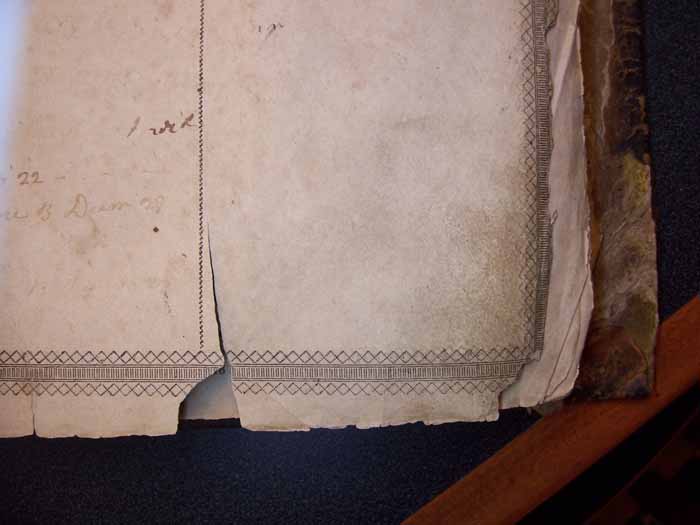
photo-15
When I turned the page I could clearly see the writing where various family members re-recorded some of the same information written on the previous page then continued to record as people died, etc. We have been told that they chose to re-write all the dates on this page 2 because the previous page 1 had faded to dim to read.
Note that the oldest child's name is spelled "Pendleton" in this page 2 of the Family Record but it is spelled "Pennington" on the next page which is torn.
John Vincent's death was recorded at the bottom of the last page (page 2) of the Family Record, seen here at the bottom-right of the page on the left. It says, "John Vincent Grandfa. departed his life May the 13 1871." Note also that the writing style of the letter "V" in Vincent written on this page is identical to the writing style of "W" in "Willburn" at the top of the next page which is torn. It would seem that both words were written by the same person some time on or after 1871.
Because of the writing style (especially the letter "V"), each name on this page seems to have been written by the same person at about the same time. Ink changes indicate that these names may have been written over a period of separate hours or days.
The only entry in different handwriting is the 12 Oct 1845 birth of Isaac's son, Isaac Marion Vincent (spelled "Marian" in this entry). Why is the handwriting different? And why is this the only grandchild written in the bible? Ida Vincent explained it in a round about way in her 1905 letter to her cousin Marion Kelly.
She said that John's son Isaac, "induced his father to exchange his land in Chambers Co for a home in Mont. Co. ... His wife was Miss Hellen Corbett who now survives. The birth of one son to them is given as Isaac Marion born Oct. 12, 1845." Ida seems to be quoting from the bible entry.
It seems also that Isaac persuaded his father John Vincent to move closer to him after Nicey died about 1851. That would explain the different handwriting recording Isaac Marion Vincent's birth. It is possible that either Isaac or his wife Hellen wrote this entry. It may have also been written by John Vincent himself since the bible belonged to him.
If so, his wife Nicey could have written all the other entries on this page except the 1871 death record for John Vincent.
John Vincent was no longer living with his son Isaac in 1860. He isn't mentioned in Isaac's household on the 1860 Montgomery County Census. It only lists 45-yr-old Isaac (spelled "ISaack" on the Census), 33-yr-old Hellen, and shows two sons -- "ISaac M." age 13 and James age 11.
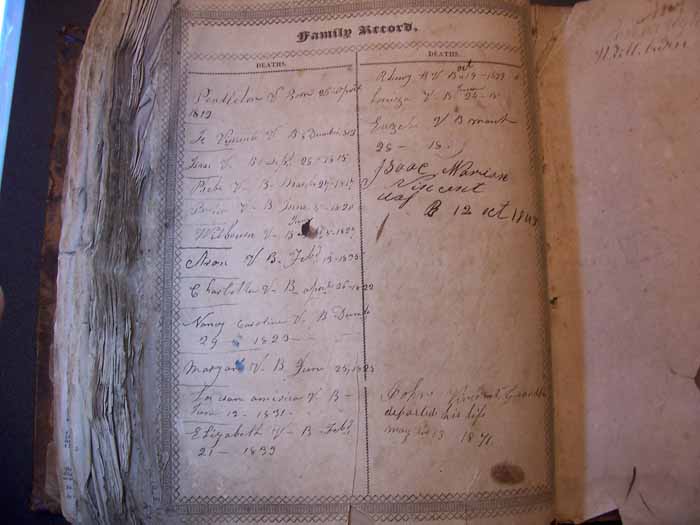
photo-16
This is a closeup of the torn page which is a blank page separator between the last page (page 2) of the Family Record and the title page of the New Testament. Wilbourne's name is spelled "Willburne" on this torn page and "Wilbourn" on the previous page which has all the names written.
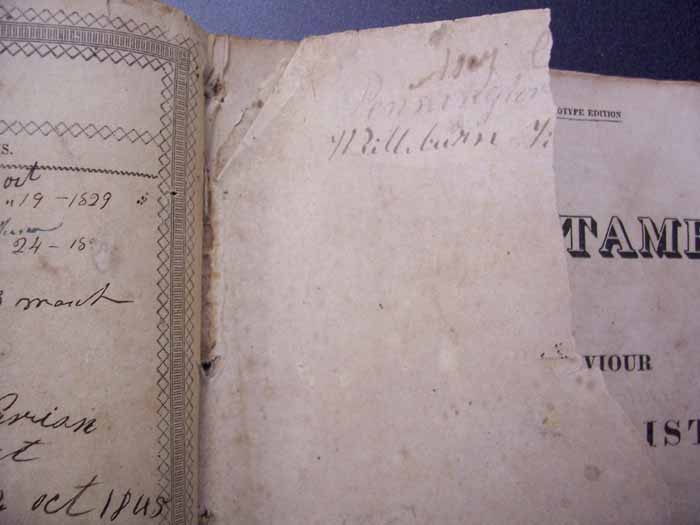
If you have slow internet, the larger example may take a few seconds to download.
My aplogies for some of these photos being slightly out of focus.
photo-1
When you first make your request of the Samford University Library - Special Collections Dept. to see the old Vincent Family Bible, you must first tell them it is part of the Bledsoe-Kelly Collection and it is located in Box SC 4320. This filing system may have changed but that's where it was when I last saw it in 2009.

photo-2
When I took the bible out of the box it was tied with a string to keep the covers on. Good idea!

photo-3
Here's what it looks like without the string.

photo-4
This is the spine of the bible.

photo-5
Inside the front cover the university attached a plate saying the bible was a gift from me and my father to the university.

photo-6
With the bible opened, the necessity of the string that held the cover own became obvious.
As you can see, several pages are missing from the front of the book.

photo-7
Several pages were missing from the front but, fortunately, the 1828 publication date was also printed at the bottom of the cover page for the New Testament. For bibles, journals, and such, a publication date lets us know how old the book is. It also tells the researcher that no dates written in this book were recorded BEFORE that date.
10 of John & Nicey's 16 children were born before this bible was published. Therefore, their date of births were recorded in this bible AFTER they were born. This means the bible is NOT a primary source for their date of birth. However, John Vincent's date of death WAS after 1828 which makes the bible a likely PRIMARY source for his death date.

photo-8
When I turned the page to view the last of 2 pages of the "Famly Record", I could see the different hand writing of several entries. This indicates that those entries were recorded at different times.

photo-9
Turning the page BACK on leaf revealed the first of 2 pages of the "Famly Record."
What you see below was taken with overhead lighting. I do not know what type lights were used.

photo-10
I brought a handheld flourescent lamp with me to see if the faded ink on the page 1 was more obvious.
This light did not seem to help much at first.

photo-11
I switched out the bulb and replaced it with an ultra-violet lamp. The faded writing here seems even harder to read, however, some of the first few letters of the oldest boys names can be made out: Pendleton or Pennington (I think his name may have changed later in life), John, and Isaac. I'm unsure who Pennington was named after but John was named after his father and Isaac was named after Nicey's father.

photo-12
I discovered when I switched back to my handheld flourescent bulb and tilted it at an angle to also allow room light from overhead, the combination of room light and my handheld flourescent seemed to make the faded writing slightly more readable.
Notice that someone had begun writing with ink that did not fade. It's a shame the same ink could have been used throughout. This says "Ben Commence[d] work first monday in Sept 1839 in Taladigga with John V _ _ _ _" None of the family members I spoke with knew what this meant.
We know that paper was a scarce commodity in new territories. We know tha that John & Nicey Vincent moved from Lincoln County, GA to Alabama sometimes between 1835 and 1840 according to Ida Vincent. We know his family ended up in Talladega County, AL. It is likely that John Vincent or Nicey wrote this work record in the only place available to them at the time. It would be nice to know who "Ben" was.
This is the top-left of the faded page 1 of the Family Record.

photo-13
Here's a closeup of the top-right of the faded page 1. Some of the names of John & Nicey's 16 children are readable including Louisiana, Elizabeth, Rhuey, and Louisa. Note that Louisa Catherine Vincent was born on the 24th of June, 1837. It is entirely possible that this was a record of her birth when she was born.
If you click to view the enlargement of this page, you can make out her first name which is spelled "Louiza" here, the capital letter "B" for "born", and most of the date "June 24, 18..." the rest is unreadable because of fading.
Below there, you can almost make out the first few letters of Euzeba's name but nothing else.

photo-14
Here's a closeup of the bottom-right of the faded page 1. There doesn't appear to be any writing in this quadrant.

photo-15
When I turned the page I could clearly see the writing where various family members re-recorded some of the same information written on the previous page then continued to record as people died, etc. We have been told that they chose to re-write all the dates on this page 2 because the previous page 1 had faded to dim to read.
Note that the oldest child's name is spelled "Pendleton" in this page 2 of the Family Record but it is spelled "Pennington" on the next page which is torn.
John Vincent's death was recorded at the bottom of the last page (page 2) of the Family Record, seen here at the bottom-right of the page on the left. It says, "John Vincent Grandfa. departed his life May the 13 1871." Note also that the writing style of the letter "V" in Vincent written on this page is identical to the writing style of "W" in "Willburn" at the top of the next page which is torn. It would seem that both words were written by the same person some time on or after 1871.
Because of the writing style (especially the letter "V"), each name on this page seems to have been written by the same person at about the same time. Ink changes indicate that these names may have been written over a period of separate hours or days.
The only entry in different handwriting is the 12 Oct 1845 birth of Isaac's son, Isaac Marion Vincent (spelled "Marian" in this entry). Why is the handwriting different? And why is this the only grandchild written in the bible? Ida Vincent explained it in a round about way in her 1905 letter to her cousin Marion Kelly.
She said that John's son Isaac, "induced his father to exchange his land in Chambers Co for a home in Mont. Co. ... His wife was Miss Hellen Corbett who now survives. The birth of one son to them is given as Isaac Marion born Oct. 12, 1845." Ida seems to be quoting from the bible entry.
It seems also that Isaac persuaded his father John Vincent to move closer to him after Nicey died about 1851. That would explain the different handwriting recording Isaac Marion Vincent's birth. It is possible that either Isaac or his wife Hellen wrote this entry. It may have also been written by John Vincent himself since the bible belonged to him.
If so, his wife Nicey could have written all the other entries on this page except the 1871 death record for John Vincent.
John Vincent was no longer living with his son Isaac in 1860. He isn't mentioned in Isaac's household on the 1860 Montgomery County Census. It only lists 45-yr-old Isaac (spelled "ISaack" on the Census), 33-yr-old Hellen, and shows two sons -- "ISaac M." age 13 and James age 11.

photo-16
This is a closeup of the torn page which is a blank page separator between the last page (page 2) of the Family Record and the title page of the New Testament. Wilbourne's name is spelled "Willburne" on this torn page and "Wilbourn" on the previous page which has all the names written.

~ END ~